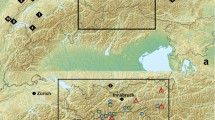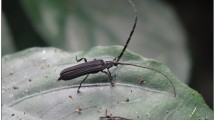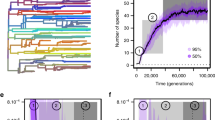Abstract
Although gene flow is an important determinant of evolutionary change, the role of ecological factors such as specialization in determining migration and gene flow has rarely been explored empirically. To examine the consequences of dispersal ability and habitat patchiness on gene flow, migration rates were compared in three cactophagous longhorn beetles using coalescent analyses of mtDNA sequences. Analyses of covariance were used to identify the roles of dispersal ability and habitat distribution in determining migration patterns. Dispersal ability was a highly significant predictor of gene flow (p< 0.001), and was more important than any other factor. These findings predict that dispersal ability may be an import factor shaping both microevolutionary and macroevolutionary patterns; this prediction is borne out by comparisons of species diversity in cactus-feeding groups.
Similar content being viewed by others
References
J. Antonovics (1992) Towards community genetics R.L. Fritz E.L. Simms (Eds) Plant Resistance to Herbivores and Pathogens University of Chicago Press Chicago 426–449
J.C. Avise (1994) Molecular Markers, Natural History and Evolution Chapman and Hall New York
M.H. Badii A.E. Flores (2001) ArticleTitlePrickly pear cacti pests and their control in Mexico Florida Entomologist 84 503–505
R.E. Blackwelder (1982) Checklist of the Coleopterous Insects of Mexico, Central America, The West Indies and South America Smithsonian Institution Washington, D.C
D. Brown (1994) Biotic Communities University of Utah Press Southwestern United States and Northwestern Mexico
D.E. Brown F. Reichenbacher S.E. Franson (1998) Classification of North American Biotic Communities University of Utah Press Salt Lake City
J.C. Burger S.M. Louda (1994) ArticleTitleIndirect versus direct effects of grasses on growth of a cactus (Opuntia fragilis) - Insect herbivory versus competition Oecologia 99 79–87 Occurrence Handle10.1007/BF00317086
Byers J.A., 1999. Great circle distance calculated between points on earth given latitude and longitude. Western Cotton Research Lab
S.J. Carlquist (1974) Island Biology Columbia University Press New York
C.E. Carlton T.J. Kring (1994) ArticleTitleMelitara prodenialis Walker on prickly pear in arkansas Southwestern Entomologist 19 23–31
J. Collins (2003) ArticleTitleWhat can we learn from community genetics? Ecology 84 574–576
C. Crosswhite F. Crosswhite (1985) ArticleTitleTrichocerues as a potential nursery crop in southern Arizona, with discussion of the Opuntia borer (Cerambycidae: Moneilema gigas) as a serious threat to its cultivation Desert Plants 7 195–203
S. Dobler B.D. Farrell (1999) ArticleTitleHost use evolution in Chrysochus milkweed beetles: evidence form behavior, population genetics and phylogeny Molecular Ecology 8 1297–1307 Occurrence Handle10.1046/j.1365-294X.1999.00693.x Occurrence Handle10447870 Occurrence Handle1:STN:280:DyaK1Mzns1Onug%3D%3D
T. Dobzhansky (1937) Genetics and the Origin of Species Columbia University Press New York
B.D. Farrell (1998) ArticleTitleInordinate fondness explained: why are there so many beetles? Science 281 555–559 Occurrence Handle10.1126/science.281.5376.555 Occurrence Handle9677197 Occurrence Handle1:CAS:528:DyaK1cXkvFCrs7k%3D
B.D. Farrell (2001) ArticleTitleEvolutionary assembly of the milkweed fauna: Cytochrome Oxidase I and the age of Tetraopes beetles Molecular Phylogenetics and Evolution 18 467–478 Occurrence Handle10.1006/mpev.2000.0888 Occurrence Handle11277638 Occurrence Handle1:CAS:528:DC%2BD3MXit1ansbc%3D
B.D. Farrell C. Mitter (1994) ArticleTitleAdaptive radiation in insects and plants: time and opportunity American Zoologist 34 57–69
T.H. Fleming J.N. Holland (1998) ArticleTitleThe evolution of obligate pollination mutualisms: senita cactus and senita moth Oecologia 114 368–375 Occurrence Handle10.1007/s004420050459
D.J. Futuyma (1987) ArticleTitleOn the role of species in anagenesis The American Naturalist 130 465–473
D.J. Futuyma G. Moreno (1988) ArticleTitleThe evolution of specialization Annual Review of Ecology and Systematics 19 207–233 Occurrence Handle10.1146/annurev.es.19.110188.001231
Goudet J., 2002. FSTAT, version 2.9.3.2. Institute of Ecology, UNIL
J. Herring (1980) ArticleTitleReview of the cactus bugs of the genus Chelinidea with the description of a new species (Hemiptera, Coreidae) Proceedings of the Entomological Society of Washington 82 237–251
S.T. Kelley B.D. Farrell J. Mitton (2000) ArticleTitleEffects of specialization on genetic differentiation in sister species of bark beetles Heredity 84 218–227 Occurrence Handle10.1046/j.1365-2540.2000.00662.x Occurrence Handle10762392
J.K. Liebherr (1988) ArticleTitleGene flow in ground beetles (Coleoptera: Carabidae) of differing habitat preference and flight-wing development Evolution 42 129–137
S. Lingafelter (2003) ArticleTitleNew host and elevational records for Moneilema appressum (Coleoptera: Cerambycidae) Journal of the New York Entomological Society 111 51–56
Linsley E.G. & Chemsak J.A., 1984. The Cerambycidae of North America, Part VII, No 1: Taxonomy and Classification of the subfamily Lamiinae, tribes Parmenini through Acanthoderini. University of California Press, Berkeley
W.P. Maddison D. Maddison (2001) MacClade Sinauer Associates Sunderland, MASS
J. Mann (1969) Cactus-Feeding Insects and Mites Smithsonian Institution Washington, DC
E. Mayr (1942) Systematics and the Origin of Species Harvard University Press Cambridge
E. Mayr (1963) Animal Species and Evolution Harvard University Press Cambridge
M. Mendez R. Duran I. Olmsted K. Oyama (2004) ArticleTitlePopulation dynamics of Pterocereus gaumeri, a rare and endemic columnar cactus of Mexico Biotropica 36 492–504 Occurrence Handle10.1111/j.1744-7429.2004.tb00345.x
C. Mitter B. Farrell B. Wiegmann (1988) ArticleTitleThe phylogenetic study of adaptive zones: has phytophagy promoted insect diversification? The American Naturalist 132 107–128
P.J. Morin (2003) ArticleTitleCommunity ecology and the genetics of interacting species Ecology 84 577–580
R. Nielsen J. Wakeley (2001) ArticleTitleDistinguishing migration from isolation: a Markov Chain Monte Carlo approach Genetics 158 885–896 Occurrence Handle11404349 Occurrence Handle1:CAS:528:DC%2BD3MXltFSisbg%3D
E. Nieman (1991) ArticleTitleThe Introduction of Mimorista pulchellalis (Lepidoptera, Pyraustidae) into South-Africa for the Biological-Control of Jointed Cactus, Opuntia-Aurantiaca. 1. Biology and Mass-Rearing Techniques Entomophaga 36 69–76
C.W. O’Brien (1969) ArticleTitleA taxonomic revision of the genus Gerstaeckeria North of Mexico (Coleoptera: Curculionidae) Annals of the Entomological Society of America 63 255–272
P.S. Oliveira V. Rico-Gray C. Diaz-Castelazo C. Castillo-Guevara (1999) ArticleTitleInteraction between ants, extrafloral nectaries, and insect herbivores in Neotropical coastal sand dunes: herbivore deterrence by visiting ants increases fruit set in Opuntia stricta (Cactaceae) Functional Ecology 13 623–631 Occurrence Handle10.1046/j.1365-2435.1999.00360.x
S.B. Peck P. Wigfull G. Nishida (1999) ArticleTitlePhysical correlates of insular species diversity: the insects of the Hawaiian Islands Annals of the Entomological Society of America 92 529–536
G. Perez Guerra M. Kosztarab (1992) Biosystematics of the Family Dactylopiidae (Homoptera: Coccinea) with Emphaisis on the Life Cycle of Dactylopius coccus Viriginia Agricultural Experiment Station, Virginia Polytechnic Institute and State University Blacksburg, Virginia
M.A. Peterson R.F. Denno (1998) ArticleTitleThe influence of dispersal and diet breadth on patterns of genetic isolation by distance in phytophagous insects The American Naturalist 152 428–446
A.G. Raske (1966) Taxonomy and Bionomics of the Genus Moneilema (Coleoptera: Cerambycidae) University of California Berkeley
G.K. Roderick (1996) ArticleTitleGeographic structure of insect populations: gene flow, phylogeography, and their uses Annual Reviews in Entomology 41 325–52 Occurrence Handle1:CAS:528:DyaK28XksVyqsg%3D%3D
S. Schneider D. Rosselli L. Excoffier (2000) Arlequin vers. 2.000: A software for population genetics analysis Genetics and Biometry Laboratory University of Geneva
P. Sjodin et al. (2005) ArticleTitleOn the meaning and existence of an effective population size Genetics 169 IssueID2 1061–1070 Occurrence Handle10.1534/genetics.104.026799 Occurrence Handle15489538 Occurrence Handle1:STN:280:DC%2BD2M7gtVCqsA%3D%3D
M. Slatkin (1985) ArticleTitleGene flow in natural populations Annual Review of Ecology and Systematics 16 393–430 Occurrence Handle10.1146/annurev.ecolsys.16.1.393
M. Slatkin (1987) ArticleTitleGene Flow and the Geographic Structure of Natural Populations Science 236 787–792 Occurrence Handle3576198 Occurrence Handle1:STN:280:BiiB3cnhvV0%3D
C.I. Smith (2003) The Evolution of the Longhorn Cactus Beetles Moneilema Say (Coleoptera: Cerambycidae) and the Biogeographic History of the North American Deserts Harvard University Cambridge
C.I. Smith B.D. Farrell (2005) ArticleTitleRecent range expansions in the flightless longhorn cactus beetles Moneilema gigas and M. armatum in response to Pleistocene climate changes Molecular Ecology 14 1025–1044 Occurrence Handle15773934 Occurrence Handle1:CAS:528:DC%2BD2MXjsFalt78%3D
Smith C.I. & Farrell B.D., In Press-a. Historical Biogeography of the Longhorn Cactus Beetles: The Influence of Pleistocene Climate Changes on American Desert Communities in Biodiversity and Management of the Madrean Archipelago II: Connecting Mountain Islands and Desert Seas edited by G.J. Gottfried, United States Department of Agriculture, Fort Collins, Colorado
Smith C.I. & B.D., Farrell In Press-b. Phylogeography of the longhorn cactus beetle Moneilema appressum Leconte (Coleoptera: Cerambycidae): Was the differentiation of the Madrean sky-islands driven by Pleistocene climate changes? Molecular Ecology
M.A. Solis S.D. Hight D.R. Gordon (2004) ArticleTitleTracking the cactus moth, Cactoblastis cactorum Berg. as it flies and eats its way westward in the U.S News of the Lepidopterists’ Society 4 IssueID3 4–7
D.R. Strong J.H. Lawton S.R. Southwood (1984) Insects on Plants Harvard University Press Cambridge, MA
P. Sunnucks D.F. Hales (1996) ArticleTitleNumerous transposed sequences of mitochondrial cytochrome oxidase 1–11 in aphids of the genus Sitobion (Hemiptera: Aphididae) Molecular Biology and Evolution 13 510–524 Occurrence Handle8742640 Occurrence Handle1:CAS:528:DyaK28Xht1Kgurk%3D
A.R. Templeton (2001) ArticleTitleUsing phylogeographic analyses of gene trees to test species status and processes Molecular Ecology 10 779–791 Occurrence Handle10.1046/j.1365-294x.2001.01199.x Occurrence Handle11298987 Occurrence Handle1:CAS:528:DC%2BD3MXjvFKgu70%3D
J.N. Thompson B.M. Cunningham (2002) ArticleTitleGeographic structure and dynamics of coevolutionary selection Nature 417 735–738 Occurrence Handle12066183 Occurrence Handle1:CAS:528:DC%2BD38XksVGju70%3D
InstitutionalAuthorNameUSFWS. (1993) Cochise pincushion cactus (Coryphantha robbinsorum) recovery plan USDI Fish and Wildlife Service Albuquerque, NM
J.K. Wangberg T.B. Parker (1981) ArticleTitleNew host record for the blue cactus borer (Melitara-dentata-Grote) Southwestern Naturalist 26 440–441
M.C. Whitlock E. McCauley (1999) ArticleTitleIndirect measures of gene flow and migration Fst ≠ 1/(4Nm+1). Heredity 82 117–125
H.M. Wilkinson-Herbots R. Ettridge (2004) ArticleTitleThe effect of unequal migration rates on FST Theoretical Population Biology 66 185–197 Occurrence Handle15465120
S. Wright (1943) ArticleTitleIsolation by distance Genetics 28 139–156
S. Wright (1978) Evolution and the Genetics of Populations Vol 4: Variability within and among Natural Populations University of Chicago Press Chicago
A. Young T. Boyle T. Brown (1996) ArticleTitleThe population genetic consequences of habitat fragmentation for plants Trends in Ecology and Evolution 11 413–418 Occurrence Handle10.1016/0169-5347(96)10045-8
Zimmerman, H. & G. Granata, 2002. Insects Pests and Diseases, pp. 235–254 in Cacti: Biology and Uses edited by P.S. Nobel. University of California Press, Berkeley
Author information
Authors and Affiliations
Corresponding author
Rights and permissions
About this article
Cite this article
Smith, C.I., Farrell, B.D. Evolutionary Consequences of Dispersal Ability in Cactus-feeding Insects. Genetica 126, 323–334 (2006). https://doi.org/10.1007/s10709-005-0714-2
Received:
Accepted:
Issue Date:
DOI: https://doi.org/10.1007/s10709-005-0714-2




